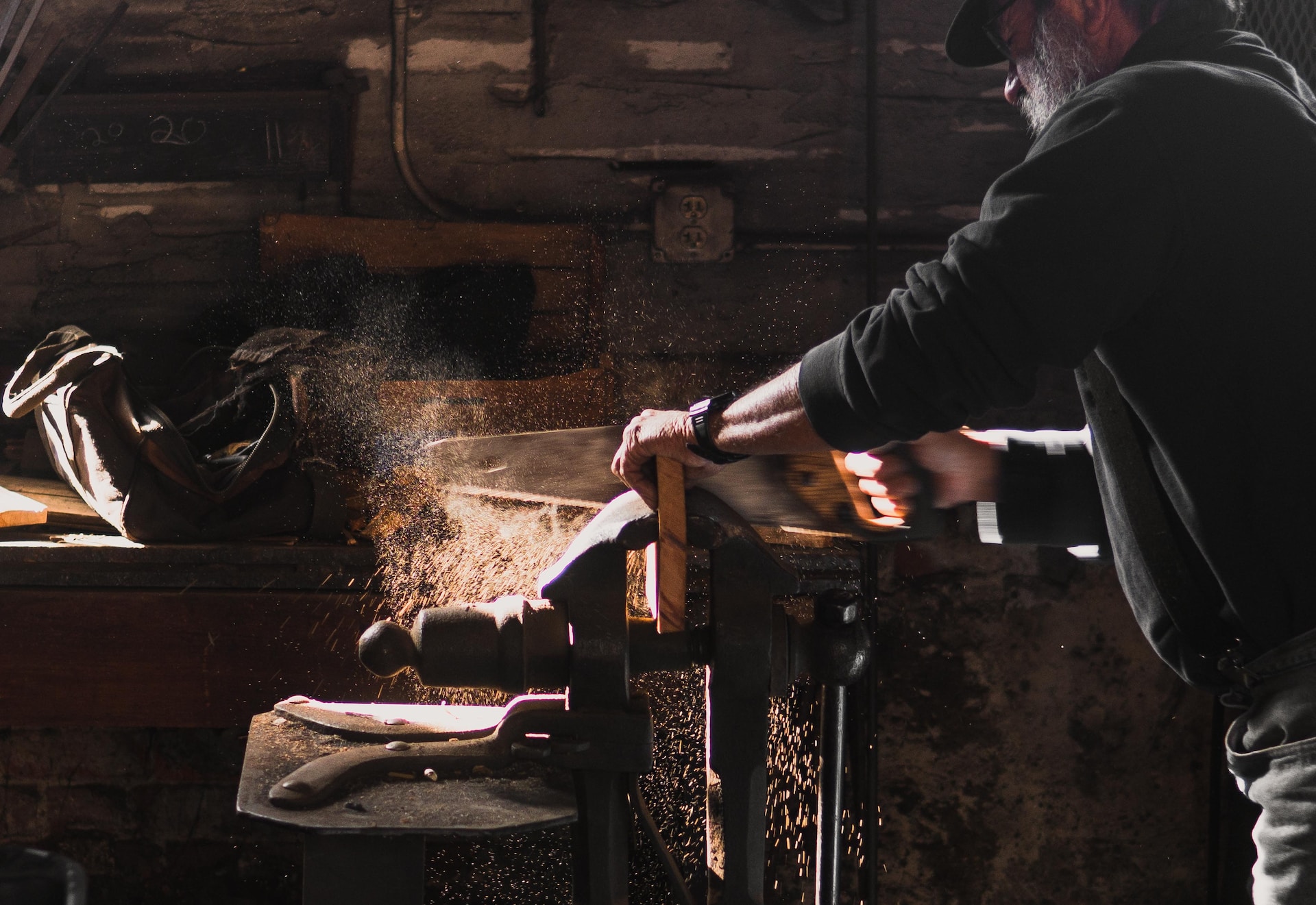Hey, I am James Brown, and welcome to my new article, where I will tell you What is Difference Between Woodworking and Carpentry?
Embarking on a project and pondering whether you need a carpenter or a woodworker? Understanding the difference between these two skilled trades is crucial for you to make the right choice. Each trade has its own set of skills and focus areas, and knowing these can save you time and resources. So, let’s delve into the nuances of woodworking and carpentry.
Key Difference:
| Aspect | Woodworking | Carpentry |
|---|---|---|
| Scope of Work | Primarily crafting artistic and decorative wood pieces. | Involves construction, framing, and practical wooden structures. |
| Skills Emphasized | Fine skills like carving, joinery, and finishing. | Practical skills in measuring, cutting, and construction. |
| Project Types | Unique furniture, sculptures, and intricate designs. | Building houses, frameworks, stairs, cabinets, and shelves. |
| Application of Knowledge | Understanding wood types, grains, and finishes. | Knowledge of structural principles, building codes, and practical aspects. |
| Artistic vs. Functional | Artistic and creative focus, emphasizing unique craftsmanship. | Primarily serves functional purposes, emphasizing practicality. |
Definition of Woodworking and Carpentry
Woodworking is an art that requires precision and creativity. It’s about crafting beautiful and intricate household items like furniture, cabinets, and decorative items – those pieces that add charm and character to your living space. Woodworkers often begin with a piece of lumber and shape it into something that’s both functional and aesthetically pleasing. Think of them as the artists creating the unique pieces that make your home feel like, well, home!
Now, carpentry on the other hand, leans towards the construction side. Carpenters are the individuals who take the crafted items or raw materials and build the structures you live and work in.
From framing houses to constructing the beams that hold your roof up, carpenters are the backbone of the building industry. They are like the directors of a play, taking the blueprints and bringing buildings to life through their skilled hands and knowledge of construction.
History and Significance of Woodworking and Carpentry
Carpentry and woodworking are old crafts. Artistic woodworking has been praised throughout history, from exquisite Japanese joinery to elegant European furniture. It’s a statement of craftsmanship and beauty via wood, not just a job.
Equally important, carpentry has physically built our communities. Carpenters built many of the past’s homes, barns, and buildings, which still survive today.
We need safe, stable structures for daily life, which highlights carpentry’s importance in modern and traditional contexts. It’s a demanding job that demands knowledge of architectural integrity and safety.
Recognising the differences between woodworkers and carpenters helps you appreciate their work and choose the best one for your project.
Woodworking Basics
Now that you’ve got a grip on the broad strokes, let’s get you closer to the heart of woodworking. As someone with an appreciation for crafted items, understanding the basics of woodworking will deepen your admiration for each piece’s uniqueness.
Understanding Different Types of Wood
Different varieties of wood have distinct properties that make them suited for a variety of projects. Hardwoods, which are derived from broadleaf trees such as oak and maple, are recognised for their durability and are frequently chosen for high-quality furniture due to their fine grain and appealing finish.
Softwoods are derived from coniferous trees such as pine and spruce. They are lighter, making them appropriate for structures requiring less bending strength, such as framing and panelling.
In addition to hardwoods and softwoods, engineered woods such as plywood and MDF are widely utilised in woodworking. These materials are adaptable and have consistent strength, but they lack the inherent beauty of solid wood. The type of wood you use will have a considerable impact on the looks, practicality, and longevity of your project.
Tools Used in Woodworking
Classic hand tools and advanced power tools are woodworking tools. Chisels, planes, and saws are centuries-old hand tools. Power equipment like jigsaws, circular saws, and sanders have made accurate cuts and finishes easier in woodworking.
Knowing your tools is crucial. A plane smooths surfaces, whereas a chisel makes details and joints. Power tools like routers can create complicated patterns and shapes.
Every tool has its purpose, and a good woodworker combines ancient methods with modern efficiency. Enjoy each learning step and tool discovery when you start woodworking since these principles will form the foundation of every beautiful piece you make or commission.
Carpentry Basics

As you delve deeper into the world of wood manipulation, it’s important to distinguish between woodworking and carpentry—they’re similar, but they’re not the same. While woodworking focuses on the artistic and detailed creation of items, carpentry zeroes in on the construction aspect of working with wood. You, with an eagerness to create, should be aware of these nuances as they will guide your projects and their execution.
Overview of Carpentry Skills and Techniques
Carpentry involves larger-scale abilities. Consider framing houses, staircases, and structures. It involves cutting and assembly like woodworking, but the focus is on durability and accuracy. You must see straight lines and angles to ensure construction safety and structural integrity. Woodworking requires mastery of hammers, nail guns, and levels to turn designs into constructions.
Carpenters must react to changing conditions on-site, making it dynamic, difficult, and practical. It’s about creating living spaces.
Different Types of Carpentry Projects
Carpentry jobs range from residential to business. You may frame a house one day and decorate a fashionable coffee shop the next. Each job involves different talents, from knowing building codes to making delicate woodwork.
Carpenters often specialize in the frame, finish carpentry, or film and theatre scenic carpentry. Carpenters have many niches to explore due to their specialization. Precision and safety make all the difference when installing cabinets or building a structure.
Remember, your passion, expertise, and attention to detail will determine your success in woodworking or carpentry. Embrace the journey—the creation is elegant and proudly built!
Key Differences Between Woodworking and Carpentry
Focus and Specialization
You may be wondering how woodworking differs from carpentry.
Let’s explore that curiosity. The art of woodworking includes crafting decorative pieces, furniture, and other intricate products. This area of woodworking is primarily about intricate joinery, smooth finishes, and individuality.
However, carpentry is best for building, fixing, and installing. Carpenters frame structures, erect rafters, and install doors and windows. In this field, you must follow architectural designs to develop beautiful, safe, and code-compliant structures.
Skills and Expertise Required
Understanding the abilities and experience needed for each discipline is crucial if you want to carve wood masterpieces. Woodworking requires precision with hand tools and machinery for cutting, shaping, and connecting wood. You patient? Detail-oriented? Excellent! Your love of meticulous work will inspire you to make family heirlooms.
However, carpentry requires knowledge of construction methods, structural design, and greater power tools and equipment. When dealing with weather or structural difficulties, problem-solving begins. Carpenters work on anything from foundations to intricate trim, but they always prioritise utility, durability, and speed.
Knowing the differences between woodworking and carpentry will help you focus your skills on the projects that match your interest and aptitude, whether you want to build a personalised dining table or a new home.
Similarities Between Woodworking and Carpentry
Utilization of Woodworking Tools
You might be curious how woodworking and carpentry are comparable, despite their differences. One aspect is woodworking tool use. Carpenters and woodworkers use many tools to form wood. Both sorts of crafters use saws, hammers, chisels, and planes.
As someone interested in any of these trades, you will be able to understand the subtleties of these instruments and learn which tool is best for a precise cut or which joinery technique to utilise. Even though crafts use the same tools, their methods and objectives vary.
Using Wood PrimarilyWoodworking links these professions. Wood may frame a building or construct a stunning jewellery box. This popular material usually sparks woodworking or carpentry interest. The fragrance of freshly cut lumber, the feel of unique grains, and the ability to turn this natural resource into something useful or beautiful make both trades rewarding.
By realising woodworking and carpentry are about wood, you may notice their similarities. Both demand respect for the material, knowledge of its properties, and tool-shaping skills. You’ll appreciate the overlap and improve your skills as you master these trades. Each has its own challenges and pleasures, but they all love woodworking.
Woodworking Projects

As you delve deeper into the world of wood crafts, understanding the distinction between woodworking and carpentry becomes crucial. You’ve learned that they both cherish wood as their primary material and utilize the same toolbox, but the way they employ their skills and tools sets them apart.
Woodworking, often considered an art, is dedicated to creating finer pieces with detail and creativity. It’s the domain where household items like furniture, cabinetry, and ornate carvings come to life.
Examples of Woodworking Projects
Imagine walking into a room and your eyes immediately being drawn to a beautifully crafted mahogany dining table with intricate carvings on its legs, or an oak bookcase with seamless joints that showcase exceptional craftsmanship. These are the fruits of woodworking. Not limited to just furniture, woodworking extends to handcrafted jewelry boxes, turned wooden bowls, and even custom-made musical instruments. It’s an endeavor of precision, patience, and artistic expression.
Carpentry, on the other hand, tends to be more about the architecture—constructing and repairing building frameworks and structures. It’s the carpenter you’ll call to install a new staircase in your home or to frame up a house. While the carpenter’s work has an aesthetic component, it’s often geared towards functionality and structural integrity.
Benefits and Challenges of Woodworking
The benefits of woodworking are manifold; it offers creative satisfaction, mental focus, and the tangible reward of a completed project. You become attuned to the details of wood grain, the subtlety of various finishes, and the quiet pride that comes from creating with your hands. The challenges, however, are also part of the journey. It requires a steady hand, an eye for design, and a willingness to continuously learn and refine your craft. Mistakes can mean starting over, but each error teaches you more about the craft, shaping you into a more skilled woodworker with every project.
Carpentry Projects
You may have already recognized your passion for wood, but as you embark on more complex projects, distinguishing between woodworking and carpentry becomes even more pertinent. Remember, woodworking is your path to creating delicate, ornamental pieces, whereas carpentry is the realm of robust construction and functional structures. Broadly speaking, carpentry is where art meets the engineering of wood.
Examples of Carpentry Projects
Imagine you’re looking to enhance your living space with a practical addition. You might decide to build a stout deck to entertain friends during summer BBQs or to erect a cozy, sturdy pergola for shade in your lavish garden. Or perhaps, the need for extra storage has become pressing, and a custom-built shed is on your list. These are classic examples of carpentry projects—large-scale constructs that require a skilled hand to ensure safety and durability. While woodworking focuses on detail and finesse, carpentry is about structural soundness and meeting specific utility needs.
Benefits and Challenges of Carpentry
Carpentry offers the satisfaction of making something big and useful. Creating a practical living area from a blueprint or idea. In contrast, the magnitude and precision of measurements and cutting provide obstacles.
Carpenters must follow building guidelines, and one mistake might damage a project. These tasks will improve your problem-solving and craftsmanship skills, building a strong portfolio.
Both carpentry and woodworking glorify wood, although in different ways. Whether you like woodworking’s beauty or carpentry’s practicality will determine your option. Any path you select will lead to meaningful creation and learning.
Career Opportunities in Woodworking and Carpentry
As you delve deeper into the world of working with wood, you’ll soon realize that woodworking and carpentry, while similar, offer diverse pathways for your career. You’ve seen that woodworking leans towards artistic endeavors, perfecting the art of crafting furniture and decorative items. On the flip side, carpentry focuses on the larger scope of building and installing structures. Let’s break down the job roles and education or training requirements for each to guide your next steps.
Job Roles and Responsibilities
Your woodworking job may involve designing and building complicated wooden objects. You’ll spend hours in a workshop perfecting small details and finishes, potentially selling your work to craft admirers or commissioning unique items. Restoring antiques or high-quality wooden items requires a keen eye and competent hand.
Carpenters commonly build building frameworks or house bones on construction sites. Carpenters must read plans, comprehend construction, and use various equipment and machines. It’s a precise, physical job that protects our homes and workplaces.
Education and Training Options
Start as a hobbyist and learn as you go, or take lessons and workshops to improve your woodworking skills. Some take fine arts diplomas or apprentice programmes to improve their skills.
Due of the importance of carpentry, training is usually more regimented. A vocational school, community college, or apprenticeship can lead to the field. These programmes teach construction technology, building codes, safety, and hands-on experience that’s essential for carpentry training.
Woodworking and carpentry are enjoyable careers that let you work with your hands and realise your dreams. Each approach is creative and practical, satisfying in its own way. Don your apron or tool belt—your craft is an expression, service, and wood-based heritage.
My Final Thought
Summary of the differences and similarities between woodworking and carpentry
You probably love wood and want to work in carpentry or woodworking. Summarising the differences and similarities can help you decide. Consider woodworking the art of the finer details, where your imagination turns raw materials into magnificent furniture and complex carvings. Carpentry, on the other hand, frames houses and buildings by measuring, cutting, and assembling huge planks and beams.
Despite their differences, woodworking and carpentry share a love of wood and the thrill of handwork. Both demand precision,
Career Opportunities in Woodworking and Carpentry
As you delve deeper into the world of working with wood, you’ll soon realize that woodworking and carpentry, while similar in nature, offer diverse pathways for your career. Woodworking focuses on the artistry of crafting furniture and decorative items, while carpentry involves building and installing structures on a larger scale. Understanding the job roles, responsibilities, and education or training requirements for each can guide your next steps in these fulfilling careers.
Job Roles and Responsibilities
Woodworking involves designing and building complicated wooden objects in a workshop. Woodworkers practise precise details and finishes for hours. They may sell their work to craft enthusiasts or commission unique works. Woodworkers can also restore antiques or high-quality wooden artefacts, which needs finesse and ability.
Carpenters, on the other hand, build frames and building structures on construction sites. Carpenters must read plans, comprehend construction, and use various equipment and machines. They use accuracy and hard labour to protect our daily buildings.
Education and Training Options
Woodworking doesn’t always require formal schooling. Many begin as enthusiasts and learn through practise and self-learning. To improve their craft, people can take classes, workshops, or earn diplomas or degrees in fine arts. Apprenticeships with experienced woodworkers are another good way to learn.
Carpenters need structured training due to the importance of their trade. Carpenters can enter the field through vocational schools, community colleges, or apprenticeships. These programmes teach construction technologies, building codes, safety, and hands-on experience. This combination is essential for becoming a professional carpenter who can safely complete construction jobs.
Both woodworking and carpentry provide rewarding careers that let you work with your hands and realise your dreams. Each approach combines creativity and practicality differently. As you put on your apron or tool belt, remember that your craft is a form of expression, a service to others, and a wood-based heritage.
FAQ”S
What is the distixnction between woodworking and carpentry?
This fundamental question can serve as an introduction to your article. You can explain the overarching differences between these two terms, highlighting their scope and the types of skills involved.
Are woodworking and carpentry terms interchangeable, or do they have distinct meanings?
Many people use the terms interchangeably, but there are subtle differences. In this section, you can elaborate on how these terms are related yet have specific contexts in which they are more appropriately used.
What skills are associated with woodworking, and how do they differ from carpentry skills?
Dive into the specific skill sets required for each discipline. Discuss the tools, techniques, and materials commonly used in woodworking and carpentry, showcasing the unique aspects that differentiate the two.
Can you provide examples of projects that fall under woodworking and carpentry?
Concrete examples can help readers visualize the distinctions between the two. Discuss common projects associated with woodworking, such as crafting furniture or artistic pieces, and contrast them with carpentry projects, which may include structural work like framing or building frameworks.
Are there any historical or cultural factors that contribute to the differentiation between woodworking and carpentry?
Explore the historical roots of woodworking and carpentry and how these practices have evolved over time. Discuss any cultural influences that may have shaped the development of these crafts, providing a broader context for readers to understand the distinctions.

I’m James Brown, the founder and editor of DIYINUSE.COM. I have over 15 years of hands-on woodworking and DIY experience that I share through tips and project inspiration on my website. When I’m not working on home improvement projects or creating content for the site, I enjoy spending time outdoors hiking and fishing. I’m always looking to expand my creativity and DIY skills by learning new techniques.
